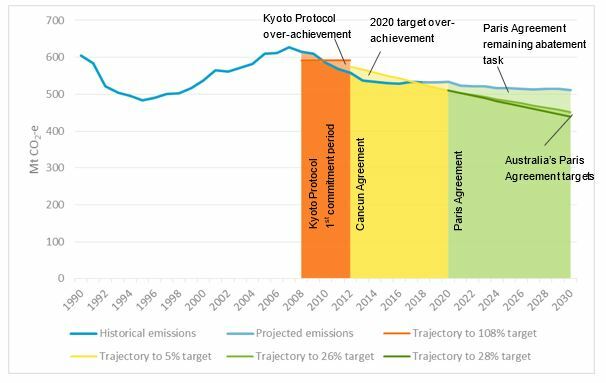In 2015, the Australian Government made a commitment to reduce Australia's emissions by 26 to 28 per cent below 2005 levels by 2030 as part of the Paris Agreement under the United Nations Framework Convention on Climate Change (UNFCCC).
In setting its target, the Australian Government advised it would use a budget approach to track progress towards the targets. Using this approach, Australia's cumulative emissions over the period 2021 to 2030 need to be limited to 4,777 Mt CO2-e for the 26% target to be met. This is also known as the ‘emissions budget' for the period. Further details are provided in Figure 3.1, below.
Source: Climate Change Authority - PROSPERING IN A LOW-EMISSIONS WORLD: AN UPDATED CLIMATE POLICY TOOLKIT FOR AUSTRALIA - March 2020
Figure 3.1 - Australia's Emissions Targets and Budget |
|
|
|
Explore the full Workshop Manual: The business case for carbon farming: improving your farm’s sustainability (January 2021)
Read the report
RESEARCH REPORTS
1. Introduction: background to the business case
This chapter lays out the basic background and groundwork of the manual
RESEARCH REPORTS
1.2 Being clear about the reasons for participating
Introduction: background to the business case
RESEARCH REPORTS
1.4 Working through the business case for carbon farming
Introduction: background to the business case
RESEARCH REPORTS
1.5 Factors determining project economics
Introduction: background to the business case
RESEARCH REPORTS
1.8 Important features of the business case
Introduction: background to the business case
RESEARCH REPORTS
2. How carbon is farmed under the ERF
This chapter considers in detail the activities that constitute carbon farming
RESEARCH REPORTS
2.5 Carbon farming under the Emissions Reduction Fund
How carbon is farmed under the ERF
RESEARCH REPORTS
3. The policy context and the price of ACCUs
This chapter takes a broad look at the policy context for carbon farming
























